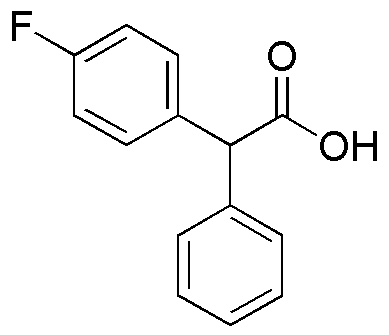2-(4-Fluorophenyl)-2-Phenylacetic Acid is widely utilized in research focused on:
- Pharmaceutical Development: This compound serves as a key intermediate in the synthesis of various pharmaceuticals, particularly in the development of anti-inflammatory and analgesic drugs.
- Biochemical Research: It is used in studies investigating the mechanisms of pain and inflammation, helping researchers understand how to better target these conditions therapeutically.
- Drug Formulation: The compound can enhance the solubility and bioavailability of certain drugs, making it valuable in the formulation of effective medications.
- Analytical Chemistry: It is employed as a standard in analytical methods, facilitating the accurate measurement of related compounds in biological samples.
- Material Science: This chemical is explored for its potential applications in creating novel materials with specific properties, such as improved thermal stability or chemical resistance.
General Information
Properties
Safety and Regulations
Applications
2-(4-Fluorophenyl)-2-Phenylacetic Acid is widely utilized in research focused on:
- Pharmaceutical Development: This compound serves as a key intermediate in the synthesis of various pharmaceuticals, particularly in the development of anti-inflammatory and analgesic drugs.
- Biochemical Research: It is used in studies investigating the mechanisms of pain and inflammation, helping researchers understand how to better target these conditions therapeutically.
- Drug Formulation: The compound can enhance the solubility and bioavailability of certain drugs, making it valuable in the formulation of effective medications.
- Analytical Chemistry: It is employed as a standard in analytical methods, facilitating the accurate measurement of related compounds in biological samples.
- Material Science: This chemical is explored for its potential applications in creating novel materials with specific properties, such as improved thermal stability or chemical resistance.
Documents
Safety Data Sheets (SDS)
The SDS provides comprehensive safety information on handling, storage, and disposal of the product.
Product Specification (PS)
The PS provides a comprehensive breakdown of the product’s properties, including chemical composition, physical state, purity, and storage requirements. It also details acceptable quality ranges and the product's intended applications.
Certificates of Analysis (COA)
Search for Certificates of Analysis (COA) by entering the products Lot Number. Lot and Batch Numbers can be found on a product’s label following the words ‘Lot’ or ‘Batch’.
Número de catálogo
Número de lote/lote
Certificates Of Origin (COO)
This COO confirms the country where the product was manufactured, and also details the materials and components used in it and whether it is derived from natural, synthetic, or other specific sources. This certificate may be required for customs, trade, and regulatory compliance.
Número de catálogo
Número de lote/lote
Safety Data Sheets (SDS)
The SDS provides comprehensive safety information on handling, storage, and disposal of the product.
DownloadProduct Specification (PS)
The PS provides a comprehensive breakdown of the product’s properties, including chemical composition, physical state, purity, and storage requirements. It also details acceptable quality ranges and the product's intended applications.
DownloadCertificates of Analysis (COA)
Search for Certificates of Analysis (COA) by entering the products Lot Number. Lot and Batch Numbers can be found on a product’s label following the words ‘Lot’ or ‘Batch’.
Número de catálogo
Número de lote/lote
Certificates Of Origin (COO)
This COO confirms the country where the product was manufactured, and also details the materials and components used in it and whether it is derived from natural, synthetic, or other specific sources. This certificate may be required for customs, trade, and regulatory compliance.


